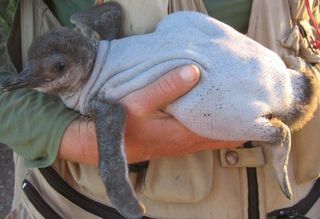Balding Penguins Baffle Scientists

Naked penguins with patches of bare skin have been popping up in the South Atlantic in recent years, puzzling scientists as to what could be causing a condition known as feather-loss disorder.
New research has now documented the balding in chicks of African penguins (Spheniscus demersus) and Magellanic penguins (Spheniscus magellanicus) in captivity and in the wild, suggesting possible causes of the disorder, which can lead to slower growth and even death in some chicks. [The 500 Cutest Animals]
"Feather-loss disorders are uncommon in most bird species, and we need to conduct further study to determine the cause of the disorder and if this is in fact spreading to other penguin species," said P. Dee Boersma of the Wildlife Conservation Society (WCS), in a statement. Boersma has conducted studies on Magellanic penguins for more than three decades.
Scientists first discovered the feather-loss disorder in African penguin chicks in a rehabilitation center in Cape Town, South Africa. [Images of balding penguin chicks]

During 2006, about 7 percent of the 854 African penguin chicks admitted to the facility lost their feathers, a number that increased to 18 percent of 538 admitted in 2007, and then dropped to 11 percent of the chicks admitted in 2008. In 2008, scientists found the disorder in African penguin chicks in the wild.
Meanwhile in 2007, on the other side of the South Atlantic, researchers from WCS and the University of Washington discovered feather-loss disorder in the chicks of wild Magellanic penguins, which are closely related to African penguins. They identified the disorder in 13 penguins from four colonies along Argentina's coastline.
And while the feathered chicks sought out shade in Argentina's hot midday sun, featherless chicks remained in the sun's glare. In fact, several of the "naked" chicks died during the study ( though after several weeks, four of the penguins grew normal juvenile plumage).
Sign up for the Live Science daily newsletter now
Get the world’s most fascinating discoveries delivered straight to your inbox.
In both South Africa and Argentina, penguin chicks with feather-loss disorder grew more slowly and were smaller than feathered chicks. Their small size and lighter weight were likely due to the increased energy spent in keeping their bodies at a healthy temperature in the absence of an insulating coat of feathers and/or down.
"The main problem with this disorder is that chicks must put extra energy into thermoregulation and thus have higher energetic demands than normal chicks making starvation more likely," said study researcher Olivia Kane of the University of Washington in Seattle. "Also, depending on the weather they may die from exposure."

Feather-loss disorders — though uncommon — can be caused by pathogens, thyroid disorders, nutrient imbalances, pollution or genetics, the researchers say. They aren't sure whether the disease is infectious and spreads between penguins.
"I think it is very likely we will see this in other species of penguins," Kane told LiveScience. "We do not know what causes the disorder yet so cannot say whether or not it is infectious."
However, the researchers did find that "feather loss was more common in the rehabilitation center than in the wild, indicating the disorder is more likely to occur in close contact and enclosed spaces," the researchers write in the current issue of the journal Waterbirds.
"We need to learn how to stop the spread of feather-loss disorder, as penguins already have problems with oil pollution and climate variation," Boersma said. "It's important to keep disease from being added to the list of threats they face."
In past research, Boersma has found that Magellanic penguin numbers at Punta Tombo, Argentina, have declined by more than 20 percent in the last two decades, from 300,000 to just 200,000 breeding pairs.
You can follow LiveScience managing editor Jeanna Bryner on Twitter @jeannabryner.

Jeanna served as editor-in-chief of Live Science. Previously, she was an assistant editor at Scholastic's Science World magazine. Jeanna has an English degree from Salisbury University, a master's degree in biogeochemistry and environmental sciences from the University of Maryland, and a graduate science journalism degree from New York University. She has worked as a biologist in Florida, where she monitored wetlands and did field surveys for endangered species. She also received an ocean sciences journalism fellowship from Woods Hole Oceanographic Institution.
